Tetris: An Introduction to the Gameplay Loop.
This is my second entry for the Archdruid Gaming Contest: The 80's. See my previous entry, on BattleTech, here.
Tetris has made its mark as one of the most recognizable games. Rebooted on many occasions, often with very few changes required, it is an instantly recognizable game. Simple enough to be intuitive, yet permitting an almost unlimited skill ceiling, it is an example of a great "early modern" game.
What makes it so interesting is the presence of a clearly defined gameplay loop.
What I mean by this is that it is neither strictly a competition (e.g. Pong), nor strictly mimetic of real world scenarios or dependent on running through a script (e.g. Colossal Cave Adventure).
That is to say that play loops, it does so automatically, and the player has enough room to make meaningful decisions.
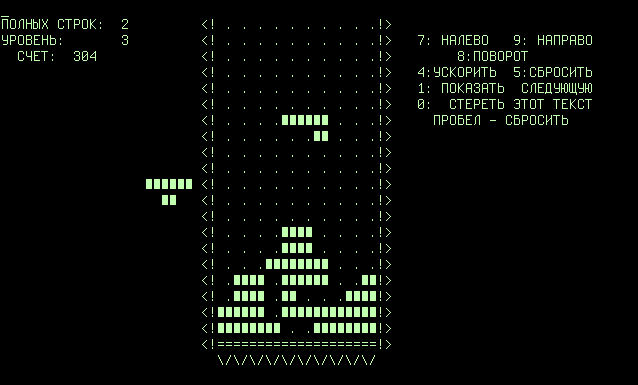
The original Tetris, in Russian, from the early 1980's. From Wikimedia Commons.
The Gameplay Loop
The concept of a gameplay loop is simple. It is the notion that a fundamental layer of play is repeated over and over, potentially infinitely. This wasn't started with Tetris, with other games like Pac-Man and even Pong having a similar system where the same activities would be repeated over and over as part of the play experience. This made it quite easy to have a game that could be played for a longer period of time.
Compare this, for example, with the game Adventure for the Atari 2600. It does not have a gameplay loop of any complexity, and instead simply has the player move a character around a series of rooms. There are gameplay elements, and you could argue that there is a very simple gameplay loop in the notion of moving from room to room, but it is not a sophisticated loop to the point that it would make a meaningful study beyond that of a programming exercise.
If one were to consider the gameplay loop found in Adventure as consisting of the movement between room to room, we would not see the same degree of possibility of mastery that we would see in more developed gameplay loops, as found in Tetris.
I've found in my experience that there are three main requirements for a good gameplay loop (defined as one in which the player can replay the game on the merit of the gameplay itself, in lieu of any other attractions like storytelling or ):
- The player has an opportunity to grow their skills and become better at playing the game.
- The loop can be used as an alternative to simply creating more content without causing players to feel like the game is stretched thin.
- The loop provides a consistent unifying experience so that players know what they are getting into as they enter new scenes of the game.
Growing in Skill
Tetris has a very simple core loop. Rotate, position, and drop blocks from the top of the screen to the bottom parts of the screen. Since it is a game, and not an interactive wallpaper, there have to be additional elements of play, but the central concept can be communicated beautifully in a single sentence.
Let's consider other features of Tetris:
- The screen space is limited to a fixed number of rows and columns.
- When an entire row is filled, it is cleared.
- Random blocks composed of four 1x1 units fall from the top of the play area,
- Not every combination of falling blocks intuitively stacks so that it can fill an entire row.
- There is time pressure, in the sense that players can make blocks fall faster, but blocks will always continue to fall even if the player does not attempt to call more blocks.
- If the player fails to keep the screen clear, and a block falls in such a way that it cannot fit onto the playing space, the game is over.
- Points are scored when the player fills a row, permitting a comparison between runs.
There are also a few non-core features, like having multiple waves (as waves advance, blocks begin falling more quickly) and the ability to hold a block, but we will not worry too much about them right now.
The core features that we have listed are sufficient to create a gameplay loop that is based on skill and player knowledge. I like to mark the distinction between skill, which is the practical ability to execute, and knowledge, which is the smarts and theoretical ability to understand what is going on in the game.
One of the strengths of Tetris is that it could be said to require little or knowledge. However, it is still possible to build up more advanced strategies, which permit better planning. This means that it has a floor (minimum requirement to play) which is very low, but a ceiling (best possible skill that yields a return in game performance) that is very high.
The most satisfying part of the game, however, is typically skill. Strategy games rely heavily on player knowledge as much as player skill and have a high competence floor, which means that a casual player may not be able to enjoy them. Many games that fall into this genre compensate for this by permitting a single-player or cooperative experience, rather than only competitive experiences, or have some other system that makes them more comprehensible to beginners.
In any case, the actual role of the gameplay loop is typically to interface with player skill, rather than player strategy. Player strategy effects the game holistically, and in more complex games where we can find more gameplay loops, it is often found in the intersection between different loops. This is not an absolute rule, however, and a sufficiently complex gameplay loop may manage to have its own strategic elements (e.g. if there is a time gap between decisions and outcomes and the player needs to predict correct actions).
In Tetris, skill is shown by the player's ability to respond to changing events. Because there is time pressure, which traditionally ramps up as the game continues and blocks fall ever quicker, players are encouraged to act quickly and decisively. Skill determines how long the escalation of the gameplay loop can continue, so all that is necessary is to entice the player to play. That's a subject for another day, but Tetris works well at this because it is able to create feedback that is perceived as rewarding.
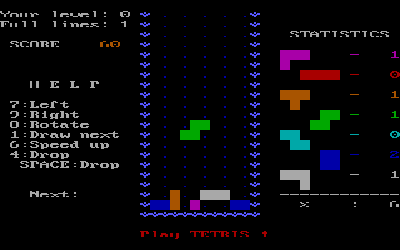
The 1986 version of DOS, courtesy of Wikimedia Commons.
Alternative to Content
Tetris is a game which requires very little actual content. In fact almost none of the game itself is based on anything which is defined on the per instance basis. Only the block shapes are truly content in a sufficiently streamlined version of the game, though some versions of the game may include other elements which serve to add story or provide an element of exploration, like having background images on locked at certain points (the Amiga version included images related to Russia, to tie into the origins of the game).
The importance of content in games is this that by providing content, the game designer gives players something to do.
Players demand novelty. They need to be able to see that each time they play something is happening that they have not yet experienced. If the same thing happens over and over, players grow bored (worse, some designers may accidentally bore their players by hiding novel outcomes from them),
Unfortunately, content is expensive. Technical limitations may restrict how much content a developer can put in a game, though this is not as common as it once was, but it also needs to be made up of new experiences for the player. Depending on the budget for things like art, writing, and programming, and the creativity of the people working on the game, it may be difficult come up with enough content to keep a player interested for long enough to feel that they have gotten their value from the experience.
Difficulty is another example of a way that you can make the game interesting. I don't think what Tetris does with ramping up speed can strictly be called difficulty in a game design sense. It is true that it relies on escalating the skill floor, but this escalating floor is not really a change in difficulty so much as a shift toward requiring higher levels of mastery.
Think of difficulty this way: How often do you want the player to succeed?
This question doesn't make sense when applied to Tetris. There is no difficulty other than the placement of the blocks. The player succeeds 100% of the time, so long as they make the right decision. Technically, Tetris is unwinnable (both because of its looping nature, and the fact that at a certain point the combination of blocks will be incompatible with maintaining a clear screen).
Consider Super Mario Brothers. This very simple platformer has its roots both in the arcade, and on the NES, which had severe technical limitations that reduced the amount of content in the game.
In Super Mario Brothers, one has to avoid hitting enemies. Otherwise, one loses a life. This is an element which is tangential to a gameplay loop. Mario's goal, the core of the main gameplay loop, is to move across the stage. The obstacles, such as falling and having to avoid enemies, are not directly related to the player's skill in moving around the stage, but rather their ability to respond to threats.
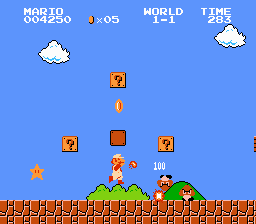
Super Mario Brothers play screenshot, courtesy of Wikimedia Commons.
There is no hostile force like this in Tetris that creates difficulty. Rather, the difficulty is a natural expression of the gameplay loop's progression: Every time the loop is completed, in this case after a set number of blocks have fallen or after a certain number of rows have been cleared, the loop repeats itself but faster this time.
This is actually something of a rarity in more complex games, but something which simple games to this day have retained. Think of a puzzle game we have to match five different types of colored object. After completing a level you may face another challenge, which is simply to match six types of colored object.
This is a self iterating process, not a tangential element applied to the Loop.
Because the loop is constantly changing due to its own nature (i.e. it undergoes self-modification), it takes the place of needing to add content that may not fit within the constraints of the game, and which the studio may not have the budget to create.
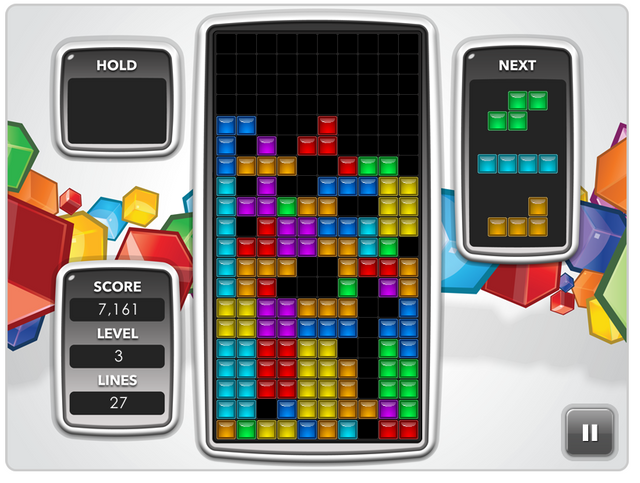
Screenshot from the modern Tetris web-game. I know I made some big goofs here.
Before we move on, I want to point out quickly that many modern "sandbox" games have problems with this step of the game. They may deliver on content, but not on a satisfying gameplay loop. Take, for example, Far Cry. It's a great game, but fifteen or more hours of the same stealth/shooting hybrid gameplay tends to grate on people, and they often extend the open world beyond what is necessary to tell the story.
Unifying Experience
When you ask someone who plays Tetris what it is at its heart, you will get different responses, but they will all be a variant of the following statement: Tetris is a game about arranging falling blocks.
As a game which has only one gameplay loop, Tetris offers us that sort of uniquely simple example which can help to shed light on more complicated games.
Take, for example, Super Mario Brothers, which we discussed earlier. Its core gameplay loop–traveling from one end of the stage to another–serves as an intermediary between many different possible experiences in the form of distinctive level content (something Tetris lacks). However, every experience within the game is presented through the lens of moving across the level.
If an enemy shows up that the player must defeat, they will do so in the same way that they would move across the stage, by jumping and moving side to side.
A very simple gameplay loop like this is helpful in clarifying what the player's objective is.
Consider a hypothetical racing game. If the player is used to driving a car around a track, this Driving Experience creates a unifying core upon which other gameplay Loops can be layered, or upon which content can be delivered. For instance, you could provide power-ups, creating a game like Mario Kart, or you could add the degree of customization and allow players the Strategic approach of choosing the best vehicle for a particular track. You could even go to an extreme and create mini-games, like stunt jumping competitions or demolition derby style play.
Classic versions of Tetris do not usually take advantage of this. However, modern spin offs have used it in a variety of ways. Some add a physics engine the blocks, like Tricky Towers, which uses the core Tetris idea of stacking polyhedrons, but develops it into a game that feels quite different, as the goal is to build the highest possible Tower rather than clearing the screen. There's still a desirable factor to filling a row, because wider towers are more stable, an emergent relationship between the two games.
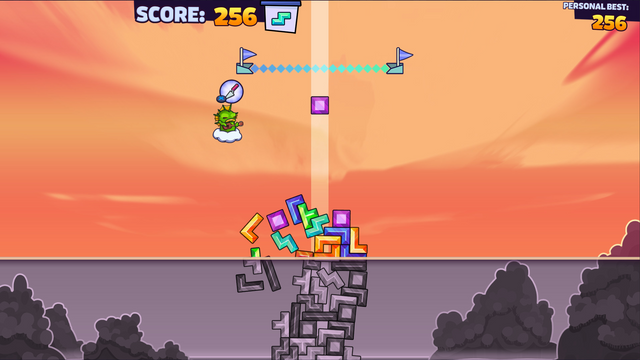
Promotional image of Tricky Towers, from the Steam store page. Used under fair use.
However, there are also variants of Tetris, like the recent Tetris 99, which add features like multiplayer by building upon the core Tetris experience and adding a new layer.
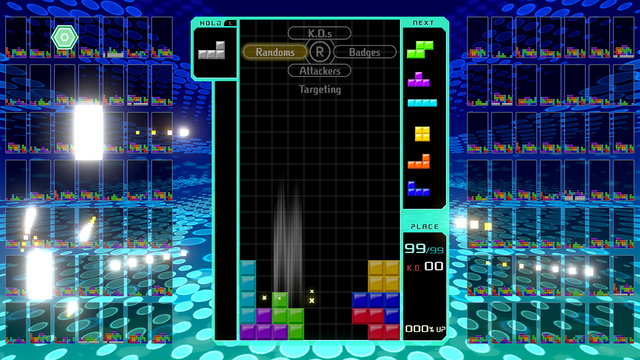
Promotional image of Tetris 99, from the Nintendo store page. Used under fair use.
Wrapping Up
Tetris makes for a great case study because it is simple without being shallow.
For a game designer, this provides an opportunity to look at the core gameplay loop of Tetris and break it down into very clear structured components. When we do so, we see that a game which is based on very simple rules can not only become a beloved classic, but also more than the sum of its parts.
This post was shared in the Curation Collective Discord community for curators, and upvoted and resteemed by the @c-squared community account after manual review.
@c-squared runs a community witness. Please consider using one of your witness votes on us here
Wow, you put a lot effort in this post. Well done!
Posted using Partiko Android
To listen to the audio version of this article click on the play image.

Brought to you by @tts. If you find it useful please consider upvoting this reply.
I found that really interesting! I love tech and programming. Thanks
Posted using Partiko Android